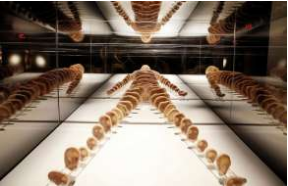Week 7: Neuroscience + Art
This
week’s topic focused on neuroscience and the brain, an obvious connection with
art as all creativity stems from the mind.
In the same way it was covered in my previous post on medicine and art,
early art with respect to the mind focused on the anatomy of the brain. Stemming off from anatomy has been the study
of neural pathways through the usage of fluorescent proteins in the Brainbow
process (Cai et. al). These fluorescent
proteins allow scientists to track “axons and dendrites over long distances”,
allowing for much greater understanding of the intricate anatomy of the brains
of several species (Harvard.edu).
Also
connecting neuroscience with art are many drugs that invoke “trips” that cause
the user to hallucinate in various forms.
One example of such a drug is LSD, which was invented by Albert Hofmann
in 1938 (Smith). While creating the compound,
Hofmann accidentally ingested it, recalling later that he "‘perceived an uninterrupted
stream of fantastic pictures, extraordinary shapes with intense, kaleidoscopic
play of colors" for about two hours’ (Biello). Cocaine has similar effects on the mind,
increasing the user’s sensitivity to sight, sound, and touch and causing
erratic, violent behavior (DrugAbuse.gov).
Both of these drugs, while used in small dosages for medical purposes,
are detrimental to the brain in large doses.
However, they are continually ingested due to these artistic
hallucinations that individuals enjoy in the short term.
 |
| Albert Hofmann |
 |
| Cocaine |
References:
Biello, David.
"Albert Hofmann, Inventor of LSD, Embarks on Final Trip." Scientific
American. N.p., 30 Apr. 2008. Web. 20 May 2017.
“Brainbow.” Center
for Brain Science, Harvard University, 2014,
cbs.fas.harvard.edu/science/connectome-project/brainbow. Accessed 20 May 2017.
Cai, Dawen,
Kimberly B. Cohen, Tuanlian Luo, Jeff W. Lichtman, and Joshua R. Sanes.
"Improved Tools for the Brainbow Toolbox." Nature Methods 10.6
(2013): 540-47. Web. 20 May 2017.
“Cocaine.” National
Institute on Drug Abuse, June 2016,
www.drugabuse.gov/publications/drugfacts/cocaine. Accessed 20 May 2017.
Smith, Craig S.
"Albert Hofmann, the Father of LSD, Dies at 102." The New
York Times. The New York Times, 29 Apr. 2008. Web. 20 May 2017.




Comments
Post a Comment